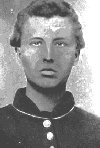 Pvt. Matthew Ledbetter
Pvt. Matthew Ledbetter
United States Army
Private, Co. D, 48th Ky. Mtd. Inf., Oct. 26, 1863 - Mar. 25, 1864
Private, Co. E, 26th Ky. Mtd. Inf., Mar. 26, 1864 - July 10, 1865
Private, Co. D, 48th Ky. Mtd. Inf., Oct. 26, 1863 - Mar. 25, 1864
Private, Co. E, 26th Ky. Mtd. Inf., Mar. 26, 1864 - July 10, 1865
Matthew Ledbetter (b. May 4, 1846 - d. Jan. 10, 1919) from Hardin County, Illinois, was the oldest son of John Ledbetter (b. 1807 in Tennessee) and Elizabeth Wright Ledbetter (b. 1812 in Kentucky). The Federal Census for Cave-In-Rock, Hardin County, Illinois taken on June 29, 1860 indicates that at that time Matthew had two older sisters: Tabitha, (b. 1841 in Illinois) and Nancy J. (b. 1844 in Illinois); one younger brother, Arthur (b. 1851 in Illinois); and one younger sister, Ruth (b. 1855 in Illinois) living at home.
 Matthew enlisted as a Private in the 48th Kentucky Mounted Infantry at Ford's Ferry, (now Rosiclare) Illinois on July 19, 1863; the service record card says he was "18 years old" although he was actually 17 at the time. He served in company D (Captain Belt's Company) from October 28, 1863 (muster-in date) through March 25, 1864 when he transferred / enlisted in the 26th Kentucky Mounted Infantry (see below). According to information given in the Compendium of the War of the Rebellion, the 48th Ky. Mtd. Inf. was organized at Princeton, Kentucky on Oct. 26, 1863. The 48th was based at Princeton, Kentucky until December 1, 1863; the men in Co. D were then moved to Bowling Green, Kentucky until April 6, 1864.
Matthew enlisted as a Private in the 48th Kentucky Mounted Infantry at Ford's Ferry, (now Rosiclare) Illinois on July 19, 1863; the service record card says he was "18 years old" although he was actually 17 at the time. He served in company D (Captain Belt's Company) from October 28, 1863 (muster-in date) through March 25, 1864 when he transferred / enlisted in the 26th Kentucky Mounted Infantry (see below). According to information given in the Compendium of the War of the Rebellion, the 48th Ky. Mtd. Inf. was organized at Princeton, Kentucky on Oct. 26, 1863. The 48th was based at Princeton, Kentucky until December 1, 1863; the men in Co. D were then moved to Bowling Green, Kentucky until April 6, 1864.
For some reason, Private Matthew Ledbetter transferred to Company E, 26th Kentucky Mounted Infantry; he enlisted for a period of 3 years on March 26, 1864 at Bowling Green, Kentucky. The enlistment document describes him as being 19 years old, blue eyes, light hair, fair complexion, and 5' 8" tall. He was then given 20 days furlough starting April 15, 1864. Starting May 5, 1864, the 26th Kentucky Mounted Infantry was assigned to post duty near Bowling Green and scouting in the region from Bowling Green to the Ohio River and the western part of Kentucky to Lexington. From Sept. 20 through Oct. 17, 1864, he participated in Burbridge's Expedition to Saltville, Virginia and was in the Battle of Saltville, Oct. 2, 1864. The 26th Kentucky Mounted Infantry was apparently detached to Colonel Hanson and was present during his ill-fated assault on the western pass that led into Saltville. Colonel Hanson was shot in the abdomen at that time. As far as can be determined, Matthew Ledbetter's unit was then under General Hobson and responsible for setting the large bonfires designed to fool the Confederate forces during the Federal army's retreat from Saltville.
Apparently, the Saltville Campaign took its toll on Matthew's health - he was admitted to Brown General Hospital in Louisville, Kentucky for "tonsillitis" on Nov. 11, 1864. On Nov. 26, 1864 he was transferred to Dennison General Hospital in camp Dennison, Ohio for "chronic diarrhea". On Jan. 10, 1865 he returned to duty at Louisville. Kentucky and was sent to rejoin his regiment at Nashville, Tennessee where he once again was sent to the hospital on Jan. 16, 1865. The Civil War ended in April of 1865, however on June 29, 1865 Matthew had apparently recovered enough to rejoin his regiment, and was sent to Cincinnati, Ohio in hopes of catching up with the 26th Kentucky Mounted Infantry now stationed in North Carolina. He was mustered out of the United States Army on July 10, 1865 at Salisbury, North Carolina.
During his absence, the 26th Kentucky Mounted Infantry had participated in the Battle of Nashville (Dec. 15-16, 1864); pursuit of Confederate General Hood to the Tennessee River (Dec. 17-28, 1864) ; capture of Wilmington. North Carolina (Feb. 22, 1865) ; Carolinas Campaign under General Sherman (Mar. 1 - April 26, 1865) and witnessed the surrender of Confederate General Johnston and his army. The 26th Kentucky Mounted Infantry lost during its service, 2 officers and 27 enlisted men killed and mortally wounded; disease killed 2 officers and 142 enlisted men for a total of 178 fatalities. It appears that Private Matthew Ledbetter was one of the lucky ones.
Matthew Ledbetter died January 10, 1919 in Cave In Rock, Hardin County, Illinois and is buried in the Cave Hill (Old Masonic) Cemetery there.
by - Kenneth Elburn Byrd - Indianapolis, Indiana
Return to Enlisted Man's Web Site